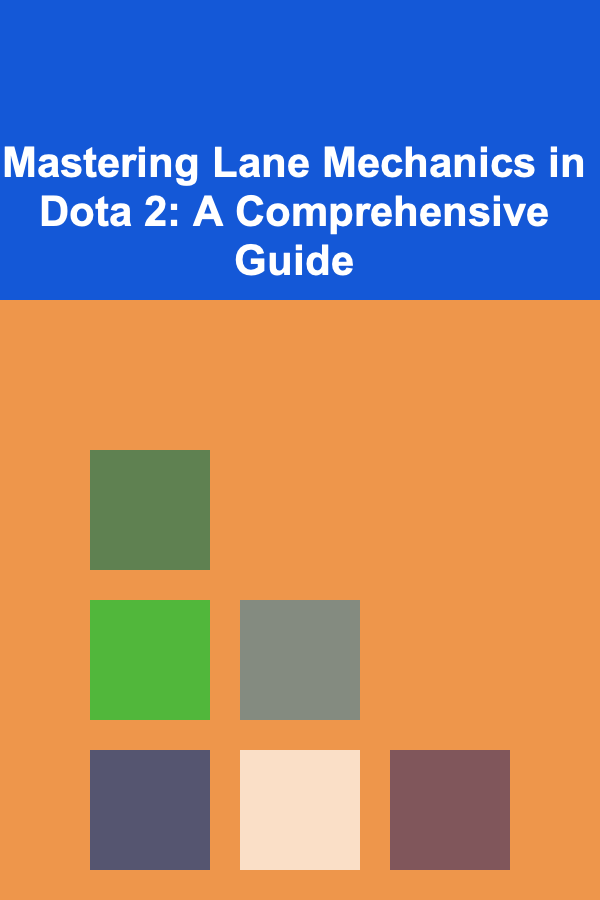
Mastering Lane Mechanics in Dota 2: A Comprehensive Guide
ebook include PDF & Audio bundle (Micro Guide)
$12.99$10.99
Limited Time Offer! Order within the next:

Laning in Dota 2 is the foundation upon which victories are built. It's a complex interplay of last hitting, denying, harassing, positioning, and map awareness. While raw mechanical skill like reflexes and APM are important, a deep understanding of lane mechanics and how to manipulate them to your advantage is what truly separates the good players from the great. This comprehensive guide delves into the intricacies of laning, providing you with the knowledge and strategies to consistently win your lane and set yourself up for success in the mid and late game.
I. Understanding the Fundamentals
A. Creep Equilibrium: The Heart of the Lane
Creep equilibrium, or creep equilibrium point, refers to the position where the two waves of creeps meet in the lane. Controlling this position is paramount to your laning success. Ideally, you want the creep equilibrium to be as close to your tower as possible without actually being under tower range. This provides several advantages:
- Safety: Being close to your tower makes you much less vulnerable to ganks from the enemy midlaner or supports.
- Experience Control: You can safely soak up experience even if you are unable to get last hits.
- Harassment Opportunity: The enemy hero has to push further forward to get last hits, making them vulnerable to harassment from you and your support.
- Jungle Access: Depending on the lane, a favorable creep equilibrium can allow you easier access to your jungle for farming or stacking camps.
The challenge lies in manipulating the creep wave to achieve this desired equilibrium. This is accomplished through a combination of last hitting, denying, and creep aggro manipulation.
B. Last Hitting and Denying: The Economic Battlefield
Last hitting and denying are the core mechanics of gaining economic advantage in the lane.
- Last Hitting: Delivering the final blow to an enemy creep to secure gold. This is your primary source of income in the early game.
- Denying: Delivering the final blow to one of your own creeps that is below 50% health (or 25% health for ranged creeps). Denying achieves two crucial things: it denies the enemy hero gold and reduces the experience they receive. It's effectively a double whammy.
Mastering last hitting and denying is a continuous process of practice and refinement. Here's a breakdown of key aspects:
- Attack Animation: Understanding the attack animation of your hero is crucial. Some heroes have fast attack animations, making last hitting easier, while others have slower animations that require more precise timing. Practice in demo mode to get a feel for your hero's attack animation.
- Damage Calculation: Keep in mind the damage your hero deals, as well as any bonus damage from items or abilities. This helps you accurately judge when to strike.
- Creep Aggro: Creeps will prioritize attacking heroes who attack enemy heroes within a certain range. Use this to your advantage to pull creep aggro and manipulate the creep wave (more on this later).
- Prediction: Anticipate when the creep will die and time your attack accordingly. This is especially important when contesting last hits against an opponent.
- Itemization: Starting items like Quelling Blade (melee heroes) or Ironwood Tree (ranged heroes) can significantly improve your last hitting ability.
Remember, even if you can't get every last hit, prioritize denying enemy creeps whenever possible. Denying a creep is often more valuable than securing a last hit, especially in the early game.
C. Harassment and Positioning: Making Life Miserable for Your Opponent
Harassment is the act of attacking or using abilities to damage and disrupt your opponent in the lane. Effective harassment can force your opponent to retreat, miss last hits, and even leave the lane entirely. Positioning is inextricably linked to harassment; it's about placing yourself in a location where you can safely harass your opponent while minimizing your own risk.
Here are some key principles of harassment and positioning:
- Respect the Creep Wave: Be mindful of the creep wave's position. Harassing an enemy hero while standing within their creep wave will draw creep aggro, causing you to take unnecessary damage.
- Attack Range Advantage: If you are a ranged hero against a melee hero, use your range advantage to harass them while staying out of their attack range.
- Abilities for Harassment: Utilize your hero's abilities to harass your opponent. Spells like Crystal Maiden's Crystal Nova or Lina's Dragon Slave are excellent for poking down the enemy hero.
- Trading Stances: Understand how to "trade" hits effectively. If you are going to take damage to harass your opponent, make sure you are dealing more damage to them in return. Consider using consumables like Tangoes or Salves to sustain yourself.
- Vision: Place wards to provide vision of the enemy's movements, allowing you to harass them safely and avoid ganks.
- Punishing Mistakes: Be ready to capitalize on your opponent's mistakes. If they overextend to get a last hit, punish them with an attack or ability.
- Threat of Kill: Your harassment should aim to create a "kill threat." If the enemy hero is low enough, they'll be forced to play passively, denying them farm and experience.
Remember to always be aware of your own safety when harassing. Don't overextend and risk being ganked.
II. Advanced Lane Mechanics
A. Creep Aggro Manipulation: The Art of Wave Control
Creep aggro manipulation is a powerful technique used to influence the movement of the creep wave. By strategically attacking enemy heroes, you can force enemy creeps to target you, pulling them away from their original path and altering the creep equilibrium.
Here's how it works:
- Attack the Enemy Hero: Click on the enemy hero within a certain range (approximately 500 units) of the creep wave.
- Creep Aggro Shift: Enemy creeps will immediately prioritize attacking you.
- Reposition: Move away from your original position, dragging the creeps with you. You can pull them towards your tower, into the jungle, or even behind your own creep wave.
Creep aggro manipulation can be used for a variety of purposes:
- Pulling the Wave: Dragging the creeps closer to your tower to farm safely.
- Pushing the Wave: Pulling the creeps behind your own wave to create a larger creep advantage and push towards the enemy tower.
- Neutralizing the Wave: If the wave is pushing too far towards the enemy tower, you can pull the creeps towards your own jungle to reset the equilibrium.
- Dodging Projectiles: You can use creep aggro to briefly move out of the path of incoming spells.
Mastering creep aggro manipulation requires practice and timing. Experiment with different ranges and movement patterns to find what works best for your hero and the situation.
B. Stacking and Pulling: Jungle Synergy
Stacking and pulling are techniques that involve manipulating the jungle creeps to either create stacks of neutral camps for later farming or to pull the lane creeps into the jungle, disrupting the creep equilibrium and providing yourself with additional farm.
- Stacking: Neutral camps respawn every minute at the minute mark (e.g., 0:00, 1:00, 2:00). To stack a camp, you need to pull the creeps out of the spawn box just before the minute mark, causing a new wave of creeps to spawn. This creates a stack of multiple creep waves in a single camp.
- Pulling: Attacking neutral creeps within a certain range of the lane will cause them to aggro onto you. You can then lead these creeps towards your lane creeps, causing the lane creeps to attack the neutral creeps. This pulls the lane equilibrium towards your side of the map and allows you to farm the jungle creeps.
Stacking and pulling are often performed by support heroes to provide additional farm for their carry and to disrupt the enemy's farm. However, core heroes can also stack and pull camps if the opportunity arises.
Here are some key considerations for stacking and pulling:
- Timing: Practice the timing of pulling camps to ensure that the lane creeps are pulled effectively.
- Camp Positioning: Choose camps that are easily accessible from the lane.
- Vision: Place wards around the pull camp to provide vision and prevent the enemy from contesting the pull.
- Carry Protection: If you are a support pulling for your carry, make sure they are safe from ganks while you are in the jungle.
C. Warding and Map Awareness: The Eyes and Ears of the Lane
Warding and map awareness are essential for surviving the laning phase and gaining an advantage over your opponent. Wards provide vision of key areas of the map, allowing you to anticipate enemy movements, avoid ganks, and make informed decisions.
Here are some common warding locations in the laning phase:
- River Wards: Placed in the river to provide vision of enemy rotations from midlane or the enemy jungle.
- Jungle Wards: Placed in the enemy jungle to provide vision of their movements and farming patterns.
- High Ground Wards: Placed on high ground to provide vision of the surrounding area and make it easier to harass enemy heroes.
- Defensive Wards: Placed near your tower to provide early warning of incoming ganks.
Effective warding is only half the battle. You also need to be constantly aware of the information that your wards provide. Keep an eye on the minimap and be ready to react to enemy movements.
Here are some tips for improving your map awareness:
- Constantly Glance at the Minimap: Make it a habit to glance at the minimap every few seconds.
- Track Enemy Heroes: Pay attention to where enemy heroes are on the map and anticipate their movements.
- Communicate with Your Team: Share information with your team about enemy movements and ward placements.
- Listen for Audio Cues: Dota 2 provides audio cues for certain events, such as the use of abilities or the movement of heroes. Pay attention to these cues to gain additional information.
Without proper warding and map awareness, you are playing Dota 2 with one hand tied behind your back.
D. Rune Control: The Power of Neutral Objectives
Runes spawn in the river every two minutes, starting at the two-minute mark. Controlling the runes can provide a significant advantage in the laning phase. There are several types of runes, each with its own unique effect:
- Bounty Rune: Provides bonus gold and experience to the hero who picks it up, as well as a smaller amount to nearby allies.
- Regeneration Rune: Fully restores health and mana over a short period.
- Haste Rune: Grants maximum movement speed for a short duration.
- Illusion Rune: Creates two illusions of the hero.
- Invisibility Rune: Grants invisibility for a short duration.
- Double Damage Rune: Doubles the hero's base damage for a short duration.
Controlling the runes can provide you with a significant advantage in the laning phase. A Bounty Rune can accelerate your farm, a Regeneration Rune can keep you in the lane, and a Haste or Invisibility Rune can be used to gank other lanes.
Here are some tips for controlling the runes:
- Time the Rune Spawns: Know when the runes are going to spawn and be prepared to contest them.
- Secure Vision: Place wards around the rune spawns to provide vision and prevent the enemy from stealing the rune.
- Coordinate with Your Team: Work with your team to secure the runes.
- Consider the Risk vs. Reward: Sometimes, contesting the rune is not worth the risk, especially if it means dying.
Remember that runes are a valuable resource, and controlling them can significantly impact the outcome of the game.
III. Hero-Specific Considerations
While the general principles of laning apply to all heroes, certain heroes have unique strengths and weaknesses that require adjustments to your laning strategy.
A. Melee Carries vs. Ranged Carries
Melee carries often have a more difficult time in the laning phase than ranged carries, as they have to get close to the creeps to last hit and are more vulnerable to harassment. To compensate for this, melee carries often rely on items like Quelling Blade to improve their last hitting and Stout Shield to reduce incoming damage.
Ranged carries, on the other hand, have the advantage of being able to harass enemy heroes from a safe distance. They can also use their range to last hit creeps without putting themselves in danger.
B. Strong Laners vs. Weak Laners
Some heroes are naturally strong laners, meaning they have abilities or stats that allow them to excel in the laning phase. Examples of strong laners include heroes like Viper, Razor, and Lina.
Other heroes are naturally weak laners, meaning they struggle to last hit, harass, or survive in the laning phase. Examples of weak laners include heroes like Anti-Mage, Phantom Lancer, and Medusa.
If you are playing a strong laner, you should aim to dominate the lane and deny your opponent farm and experience. If you are playing a weak laner, you should focus on surviving the laning phase and getting as much farm as possible without dying.
C. Ganking Heroes vs. Farming Heroes
Some heroes are more suited to ganking other lanes, while others are better off farming in their own lane. Ganking heroes typically have abilities that allow them to quickly move around the map and initiate on enemy heroes. Examples of ganking heroes include heroes like Pudge, Spirit Breaker, and Nyx Assassin.
Farming heroes, on the other hand, typically have abilities that allow them to quickly clear creep waves and jungle camps. Examples of farming heroes include heroes like Anti-Mage, Terrorblade, and Luna.
If you are playing a ganking hero, you should look for opportunities to rotate to other lanes and gank enemy heroes. If you are playing a farming hero, you should focus on farming as much as possible and avoid getting involved in unnecessary fights.
IV. Common Laning Mistakes to Avoid
Even experienced Dota 2 players can sometimes fall victim to common laning mistakes. Awareness of these pitfalls can help you avoid making them yourself.
- Ignoring Creep Equilibrium: Failing to pay attention to the creep equilibrium and allowing the wave to push too far towards the enemy tower.
- Overextending for Last Hits: Taking unnecessary risks to get last hits, putting yourself in danger of being ganked or harassed.
- Ignoring Map Awareness: Failing to pay attention to the minimap and being unaware of enemy movements.
- Failing to Ward: Not placing wards to provide vision and prevent ganks.
- Trading Poorly: Taking unnecessary damage to harass your opponent, resulting in a net loss of health.
- Tunnel Visioning: Focusing too much on last hitting and denying, and neglecting other important aspects of laning, such as harassment and positioning.
- Not Utilizing Resources: Forgetting to use consumables like Tangoes, Salves, and Clarity.
- Tilting: Letting emotions get the best of you after a bad play or a gank, which can lead to further mistakes.
By avoiding these common laning mistakes, you can significantly improve your chances of winning your lane and setting yourself up for success in the game.
V. Practicing and Improving Your Laning Skills
Mastering lane mechanics in Dota 2 requires consistent practice and a willingness to learn from your mistakes. Here are some tips for improving your laning skills:
- Demo Mode: Spend time in demo mode practicing last hitting and denying with different heroes.
- Lobby Games: Play lobby games with friends to practice laning against real opponents.
- Watch Replays: Watch replays of professional Dota 2 players to see how they lane and learn from their strategies.
- Analyze Your Own Games: Review your own replays to identify your mistakes and areas for improvement.
- Experiment with Different Heroes and Strategies: Don't be afraid to try new heroes and strategies in the laning phase.
- Focus on Fundamentals: Master the fundamentals of laning before trying to learn more advanced techniques.
- Be Patient: Improving your laning skills takes time and effort. Don't get discouraged if you don't see results immediately.
- Seek Feedback: Ask more experienced players to review your replays and provide feedback.
VI. Conclusion
Mastering lane mechanics in Dota 2 is a continuous journey. By understanding the fundamentals, practicing advanced techniques, and avoiding common mistakes, you can consistently win your lane and contribute to your team's success. Remember to always be learning and adapting to the ever-changing meta of Dota 2. Good luck, and have fun dominating the lane!

How to Create a Functional Home Office During Your Renovation
Read More
How to Design a Compact Yet Functional Home Office
Read More
How to Make Money Online as a Coach: 10 Actionable Ideas
Read More
How To Cultivate a Sense of Purpose
Read More
How to Preserve Family Photographs: A Guide for Aspiring Archivists
Read More
10 Tips for Building a Thriving Telepharmacy Practice
Read MoreOther Products

How to Create a Functional Home Office During Your Renovation
Read More
How to Design a Compact Yet Functional Home Office
Read More
How to Make Money Online as a Coach: 10 Actionable Ideas
Read More
How To Cultivate a Sense of Purpose
Read More
How to Preserve Family Photographs: A Guide for Aspiring Archivists
Read More